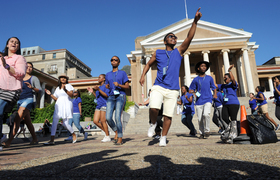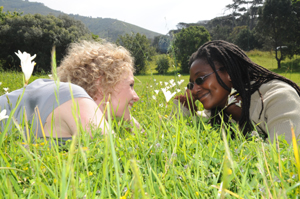 Daisy chain: Alumna Lauren Steyn (left) and staffer Shumi Chimombe get in the mood for Green Week.
Daisy chain: Alumna Lauren Steyn (left) and staffer Shumi Chimombe get in the mood for Green Week.
Green Week takes place from 28 September to 2 October on campus, an oasis where we spotlight environmentally conscious living and work at UCT. It's all part of the Green Campus Initiative (GCI), started in 2007 by a handful of students and staff. Their members have swelled from 300 to over 1 100.
While recycling has gained huge momentum, it's not enough, says GCI member Kimon de Greef, a third-year ecology student.
"Some people don't think about the environment. One will open a packet of chips and throw the bag away without thinking about where it's going. One will walk past an empty lecture theatre with lights on."
Universities have always been places of change, of new thought, he added. "With the world facing global warming and energy and water crises, we'd love to see UCT leading the way in changing that."
These are some of the initiatives they are driving, co-ordinating and applauding.
(For more information on campus events visit the UCT Green Week webpage or facebook page. Or search "UCT Green Week" on Facebook).
|
Green philosophy
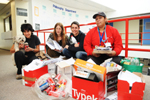 The folks at the Department of Philosophy take their recycling seriously. So everyone makes sure that paper is printed on both sides before it's dumped. They also have a regular pick-up of such paper, which earns the department a few rands in petty cash. Still not content, all staff - including the aptly-named Shamiela Green of Supercare, who pounces on any stray paper or other recyclable goodies in the office, which staffer Cindy Gilbert hauls off to Pinelands North Primary for her kids' Friday morning recycling competition. The folks at the Department of Philosophy take their recycling seriously. So everyone makes sure that paper is printed on both sides before it's dumped. They also have a regular pick-up of such paper, which earns the department a few rands in petty cash. Still not content, all staff - including the aptly-named Shamiela Green of Supercare, who pounces on any stray paper or other recyclable goodies in the office, which staffer Cindy Gilbert hauls off to Pinelands North Primary for her kids' Friday morning recycling competition.
|
|
Bin it
 UCT produces up to eight tons of waste a day. All bins on upper and middle campus have been grouped into stations and people are expected to discard waste in the correct bins. Waste is taken to a sorting facility and UCT receives some of the revenue from recycled goods. UCT produces up to eight tons of waste a day. All bins on upper and middle campus have been grouped into stations and people are expected to discard waste in the correct bins. Waste is taken to a sorting facility and UCT receives some of the revenue from recycled goods.
|
|
Easy riders
 Ridelink seeks to reduce carbon emissions from the UCT community by promoting carpooling, cycling and public transport. A key component is the Campus Carpooling system - an online database that matches interested students up with others who live in their area. Campus Carpooling saves petrol, reduces parking congestion - and you make new friends. Ridelink seeks to reduce carbon emissions from the UCT community by promoting carpooling, cycling and public transport. A key component is the Campus Carpooling system - an online database that matches interested students up with others who live in their area. Campus Carpooling saves petrol, reduces parking congestion - and you make new friends.
|
|
Light up
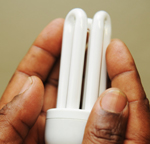 In partnership with Eskom, the GCI promotes energy saving and efficiency. Residences compete to reduce their total energy consumption. The GCI also works with house committees to raise awareness about environmental issues within the residences, such as using energy-efficient globes. Electricity meters are being fitted to each building. In partnership with Eskom, the GCI promotes energy saving and efficiency. Residences compete to reduce their total energy consumption. The GCI also works with house committees to raise awareness about environmental issues within the residences, such as using energy-efficient globes. Electricity meters are being fitted to each building.
|
|
Putting down roots
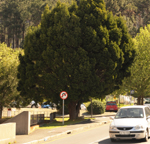 Properties and Services' clearing programme, to rid the campus of alien vegetation, is part of overall maintenance. "The entire value of our botanical biodiversity is taken into account, along with the diverse range of heritage trees and historic planting," says senior horticulturist Noelene le Cordier. "With respect to future tree planting we do not only plant indigenous trees as it's important to maintain the style that has developed over the last 100 years on campus. From a conservation point, some of the trees that are classic to the university environment are Stone Pines, Mediterranean cypresses and Outeniqua yellowwoods, which need to be kept and replanted." Properties and Services' clearing programme, to rid the campus of alien vegetation, is part of overall maintenance. "The entire value of our botanical biodiversity is taken into account, along with the diverse range of heritage trees and historic planting," says senior horticulturist Noelene le Cordier. "With respect to future tree planting we do not only plant indigenous trees as it's important to maintain the style that has developed over the last 100 years on campus. From a conservation point, some of the trees that are classic to the university environment are Stone Pines, Mediterranean cypresses and Outeniqua yellowwoods, which need to be kept and replanted."
|
|
Waterwise plants
 The Campus Biodiversity Project aims to make UCT's gardens more representative of the Cape's unique flora, such as fynbos. This provides a number of benefits such as water-use efficiency, providing a refuge for rare and endangered species and showcasing floral delights for the botanist and the layman alike, as well as boosting UCT's eco-friendly image. The Campus Biodiversity Project aims to make UCT's gardens more representative of the Cape's unique flora, such as fynbos. This provides a number of benefits such as water-use efficiency, providing a refuge for rare and endangered species and showcasing floral delights for the botanist and the layman alike, as well as boosting UCT's eco-friendly image.
|
|
Soak up the sun
 The Graça Machel and Cadboll House residences lead the way in solar power systems that work with heat pumps. Residence maintenance manager John Peters said the heat is absorbed from the sun and trapped between the flat plate panels and the glass. That heats the pipes, which heat cold water, providing between 20% and 35% of hot water for both residences. The Graça Machel and Cadboll House residences lead the way in solar power systems that work with heat pumps. Residence maintenance manager John Peters said the heat is absorbed from the sun and trapped between the flat plate panels and the glass. That heats the pipes, which heat cold water, providing between 20% and 35% of hot water for both residences.
|
 Daisy chain: Alumna Lauren Steyn (left) and staffer Shumi Chimombe get in the mood for Green Week.
Daisy chain: Alumna Lauren Steyn (left) and staffer Shumi Chimombe get in the mood for Green Week. This work is licensed under a Creative Commons Attribution-NoDerivatives 4.0 International License.
This work is licensed under a Creative Commons Attribution-NoDerivatives 4.0 International License.

 The folks at the Department of Philosophy take their recycling seriously. So everyone makes sure that paper is printed on both sides before it's dumped. They also have a regular pick-up of such paper, which earns the department a few rands in petty cash. Still not content, all staff - including the aptly-named Shamiela Green of Supercare, who pounces on any stray paper or other recyclable goodies in the office, which staffer Cindy Gilbert hauls off to Pinelands North Primary for her kids' Friday morning recycling competition.
The folks at the Department of Philosophy take their recycling seriously. So everyone makes sure that paper is printed on both sides before it's dumped. They also have a regular pick-up of such paper, which earns the department a few rands in petty cash. Still not content, all staff - including the aptly-named Shamiela Green of Supercare, who pounces on any stray paper or other recyclable goodies in the office, which staffer Cindy Gilbert hauls off to Pinelands North Primary for her kids' Friday morning recycling competition. UCT produces up to eight tons of waste a day. All bins on upper and middle campus have been grouped into stations and people are expected to discard waste in the correct bins. Waste is taken to a sorting facility and UCT receives some of the revenue from recycled goods.
UCT produces up to eight tons of waste a day. All bins on upper and middle campus have been grouped into stations and people are expected to discard waste in the correct bins. Waste is taken to a sorting facility and UCT receives some of the revenue from recycled goods. Ridelink seeks to reduce carbon emissions from the UCT community by promoting carpooling, cycling and public transport. A key component is the Campus Carpooling system - an online database that matches interested students up with others who live in their area. Campus Carpooling saves petrol, reduces parking congestion - and you make new friends.
Ridelink seeks to reduce carbon emissions from the UCT community by promoting carpooling, cycling and public transport. A key component is the Campus Carpooling system - an online database that matches interested students up with others who live in their area. Campus Carpooling saves petrol, reduces parking congestion - and you make new friends. In partnership with Eskom, the GCI promotes energy saving and efficiency. Residences compete to reduce their total energy consumption. The GCI also works with house committees to raise awareness about environmental issues within the residences, such as using energy-efficient globes. Electricity meters are being fitted to each building.
In partnership with Eskom, the GCI promotes energy saving and efficiency. Residences compete to reduce their total energy consumption. The GCI also works with house committees to raise awareness about environmental issues within the residences, such as using energy-efficient globes. Electricity meters are being fitted to each building. Properties and Services' clearing programme, to rid the campus of alien vegetation, is part of overall maintenance. "The entire value of our botanical biodiversity is taken into account, along with the diverse range of heritage trees and historic planting," says senior horticulturist Noelene le Cordier. "With respect to future tree planting we do not only plant indigenous trees as it's important to maintain the style that has developed over the last 100 years on campus. From a conservation point, some of the trees that are classic to the university environment are Stone Pines, Mediterranean cypresses and Outeniqua yellowwoods, which need to be kept and replanted."
Properties and Services' clearing programme, to rid the campus of alien vegetation, is part of overall maintenance. "The entire value of our botanical biodiversity is taken into account, along with the diverse range of heritage trees and historic planting," says senior horticulturist Noelene le Cordier. "With respect to future tree planting we do not only plant indigenous trees as it's important to maintain the style that has developed over the last 100 years on campus. From a conservation point, some of the trees that are classic to the university environment are Stone Pines, Mediterranean cypresses and Outeniqua yellowwoods, which need to be kept and replanted." The Campus Biodiversity Project aims to make UCT's gardens more representative of the Cape's unique flora, such as fynbos. This provides a number of benefits such as water-use efficiency, providing a refuge for rare and endangered species and showcasing floral delights for the botanist and the layman alike, as well as boosting UCT's eco-friendly image.
The Campus Biodiversity Project aims to make UCT's gardens more representative of the Cape's unique flora, such as fynbos. This provides a number of benefits such as water-use efficiency, providing a refuge for rare and endangered species and showcasing floral delights for the botanist and the layman alike, as well as boosting UCT's eco-friendly image. The Graça Machel and Cadboll House residences lead the way in solar power systems that work with heat pumps. Residence maintenance manager John Peters said the heat is absorbed from the sun and trapped between the flat plate panels and the glass. That heats the pipes, which heat cold water, providing between 20% and 35% of hot water for both residences.
The Graça Machel and Cadboll House residences lead the way in solar power systems that work with heat pumps. Residence maintenance manager John Peters said the heat is absorbed from the sun and trapped between the flat plate panels and the glass. That heats the pipes, which heat cold water, providing between 20% and 35% of hot water for both residences.





